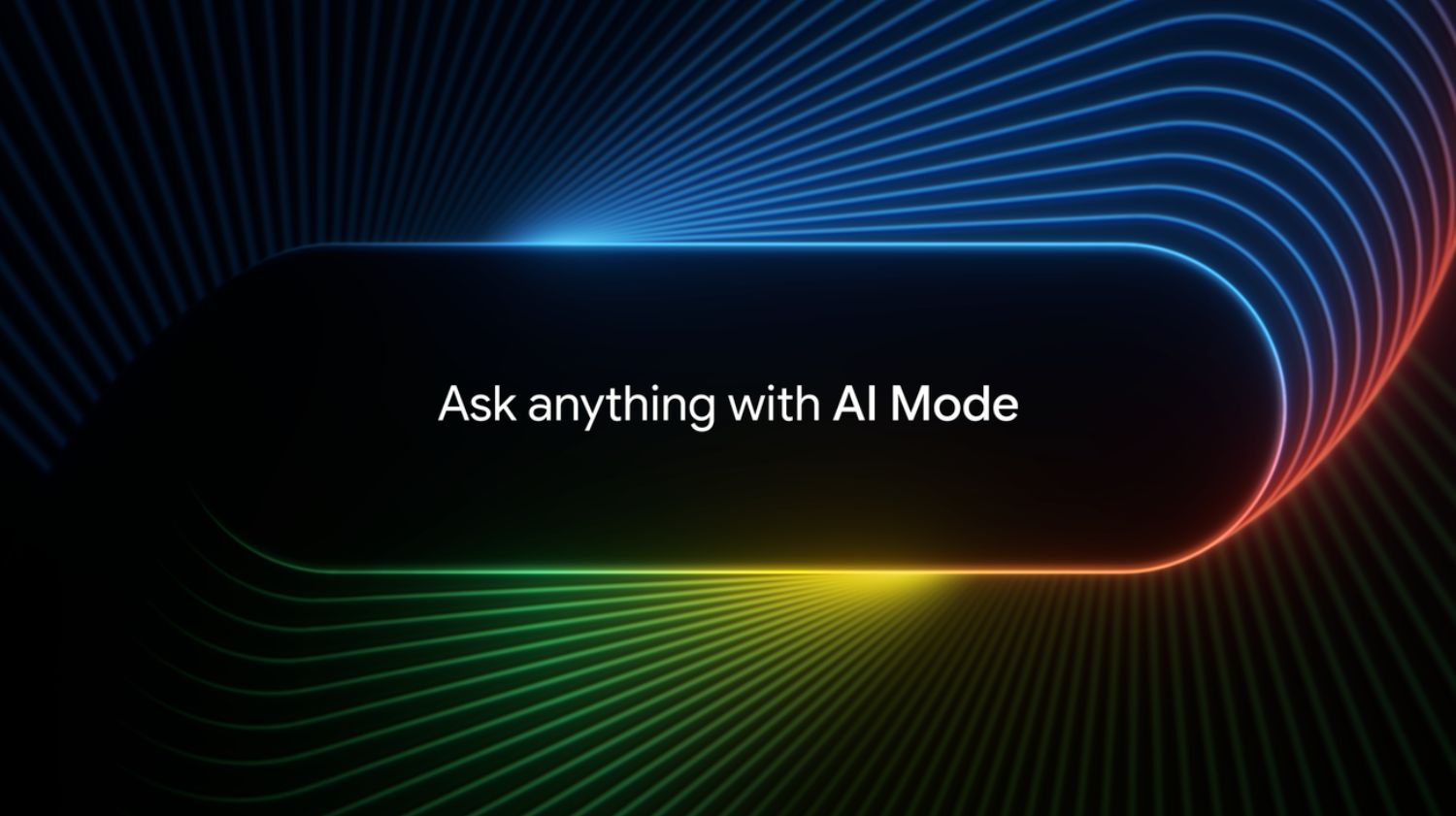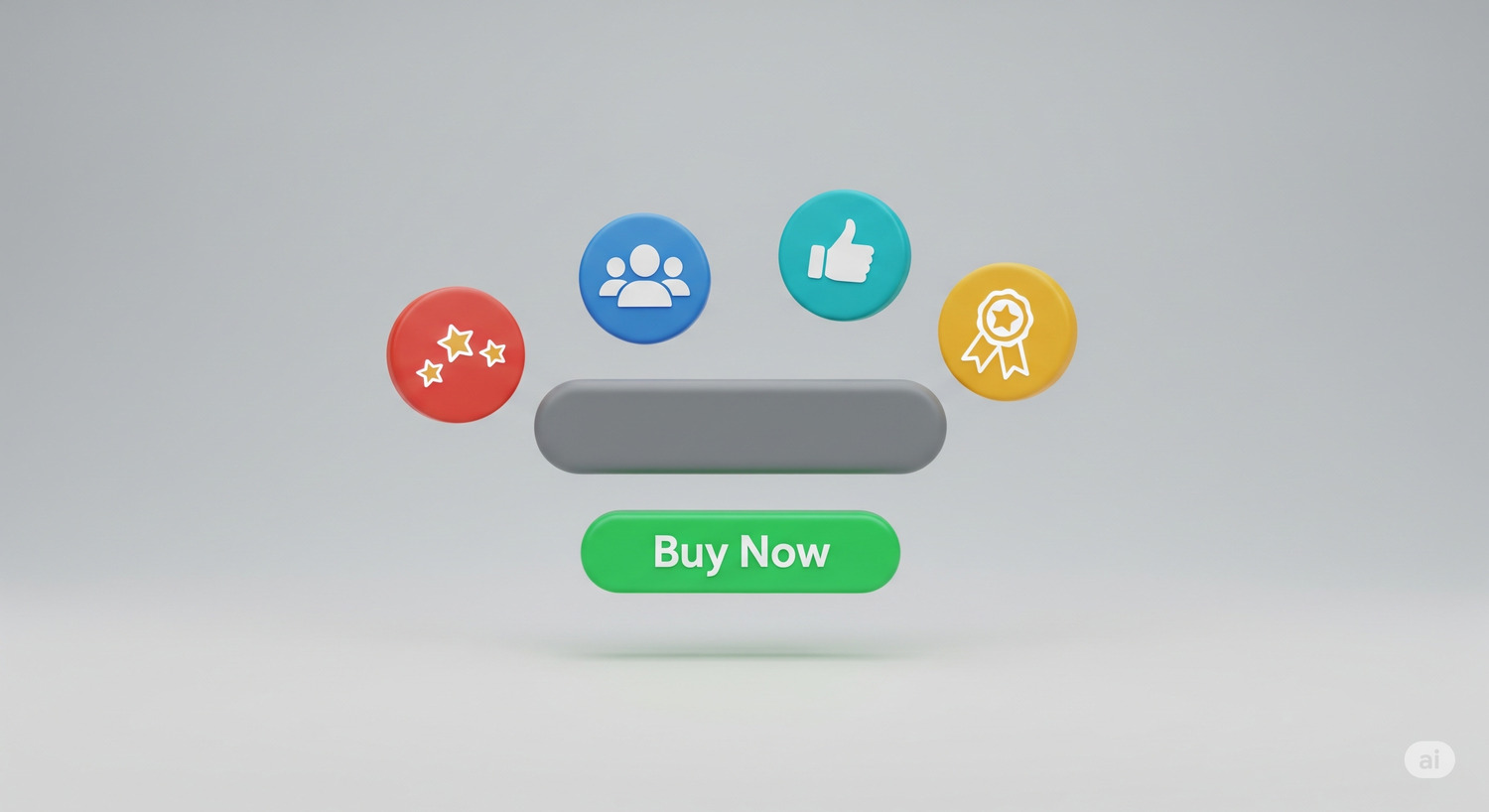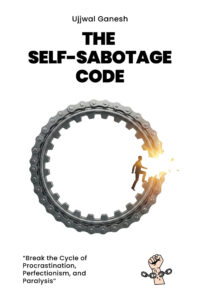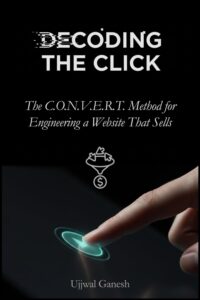Google I/O 2025 has left many in the SEO world feeling uncertain, and I’m right there with you.
Google introduced AI Mode, a new way to search that’s faster, smarter (this is what they think at least), and feels more like talking to an assistant than typing into a search box. It doesn’t just give you links. It gives you direct answers, compares products, breaks down complex topics, and lets you ask follow-up questions right inside Google.
At I/O 2025, Google announced something called AI Mode. It’s a new way to search where users ask questions and get full answers directly on the search page. No need to visit a website. No need to click anything. Just ask, read, and move on.
As someone working in SEO every day, I don’t see this as just another feature. I see it as a clear shift in control—from websites to platforms. We’ve been seeing this coming for years: clicks dropping, impressions rising, and the gap getting harder to explain to clients. Google’s just making it official now.
The truth is, Google isn’t alone. Every major platform: Facebook, YouTube, LinkedIn, Reddit has stopped sending traffic and started keeping users inside their walls. AI tools like ChatGPT and Perplexity are doing the same. We’re not just fighting for rankings anymore. We’re fighting for relevance.
That’s why I wrote this post.
Not to complain. Not to hype AI. But to help SEO professionals and agencies see what’s really changing and how to prepare for it.
First, I’ll break down what Google AI Mode is and how it changes search behavior. Then I’ll walk through the 10 biggest shifts I believe SEOs in India need to get ahead of. Finally, I’ll share the new framework I’m using in my own work: one that’s focused less on traffic, and more on visibility, trust, and action.
Because like it or not, the old playbook is done. What comes next is still ours to shape.
What Is Google AI Mode?
Google AI Mode is a new way of searching that makes Google feel more like a smart assistant than a search engine. Instead of giving you a list of links, it gives you full, AI-generated answers right inside the results page. You can ask follow-up questions, compare options, or dive deeper into a topic without clicking away.
It’s built on Google’s latest large language model, Gemini 2.5, and it’s already changing how people search.
How AI Mode Works
AI Mode breaks your query into subtopics and runs multiple searches at once. It then combines those results into a clear, conversational answer. It supports text, images, product data, maps, and more—all within a single view.
The goal is to reduce friction. No more clicking 10 links and skimming pages. Just type your question, and you get a complete answer, powered by Google’s ecosystem and the content it pulls from the web.
What Makes It Different from AI Overviews
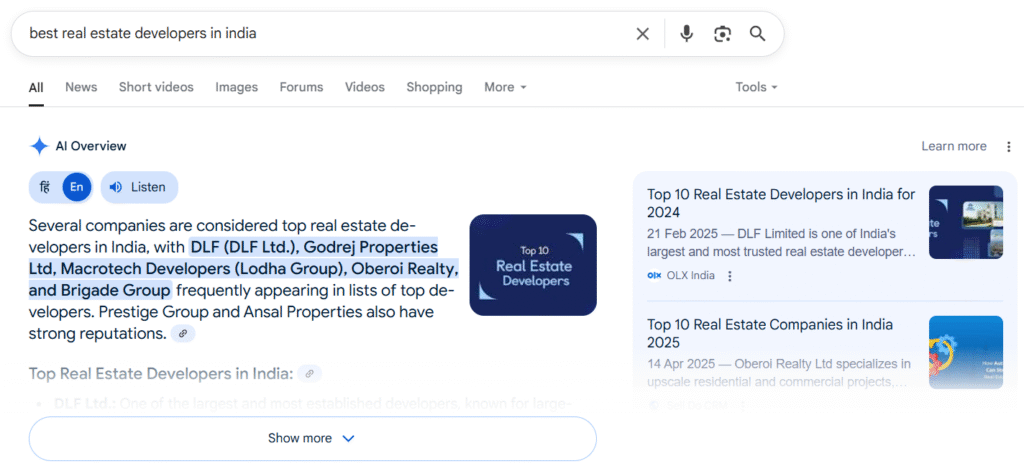
You might’ve seen AI Overviews already. Those show up in regular Google results for certain types of searches—especially ones that need summarization or multiple perspectives.
But AI Mode is more than that. It’s a dedicated mode that completely changes how search works. Once enabled, every search is conversational by default. You can keep asking follow-ups, adjust your query, or explore related topics without restarting your search.
Where AI Mode Pulls Its Information From
AI Mode uses content from a wide range of sources, including:
- Google’s Knowledge Graph
- Google Maps and GMB listings
- Product data from Merchant Center
- Publicly available web content (including publisher sites)
- Real-time web results when needed
This tight integration with Google’s own services means your brand’s presence across Google properties now matters even more.
Who Can Use It Right Now
Right now, AI Mode is only available in English and only to users in the United States who have opted into Search Labs. You can access it through:
- The Google app (mobile)
- Desktop via the search bar
- Labs.google.com (if you’re eligible)
Google has already confirmed that it’s planning a global rollout soon. Indian users—and by extension, your clients—will likely see it in action within the next few months.
How Google AI Mode Is Changing Search Behavior
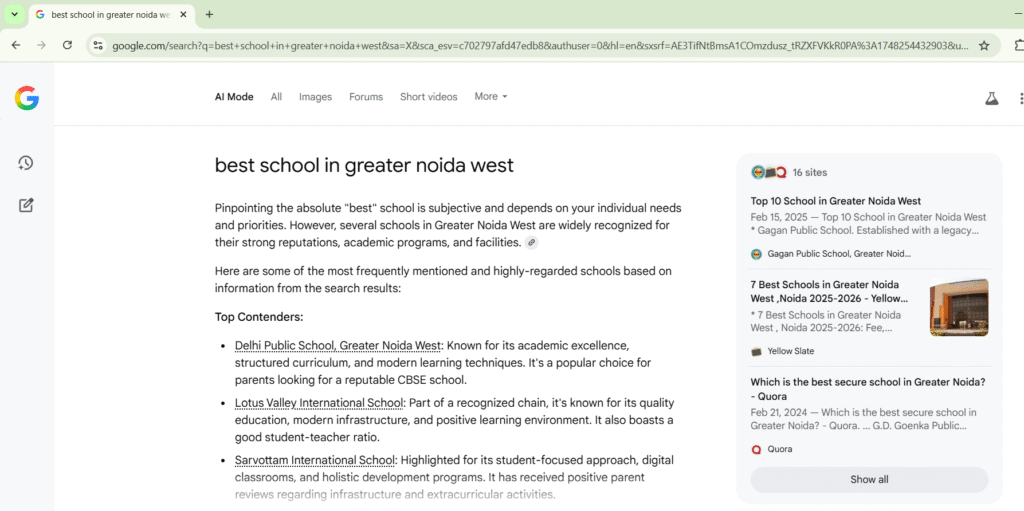
AI Mode isn’t just a new look. It’s changing how people search, how they find answers, and whether they ever leave Google at all.
Here’s what’s actually happening behind the scenes and why it matters.
1. Fewer Clicks, Even When Visibility Goes Up
One of the biggest shifts is the rise of zero-click searches. You may already be seeing this in your data. Your page might rank well. Impressions might be high. But the clicks aren’t following.
That’s because AI Mode gives users full answers directly in the results. People no longer need to click through to websites for many types of queries. For SEOs, this means classic CTR is becoming a less reliable metric. Users are getting what they need before they even see your title tag.
2. Google Now Breaks Down Queries Automatically
AI Mode uses something called query fan-out. Instead of treating one search as one query, it automatically breaks your question into smaller parts. Then it runs several searches in the background, finds relevant pieces of information, and combines them into one smooth answer.
This means Google is doing the exploring for the user. There’s less chance they’ll open new tabs, visit multiple sites, or scroll through results. The AI does the work—and the user stays on Google.
3. The Answer Becomes the Experience
In the past, search results helped people discover where to go. Now, AI answers are the destination. For many users, that first AI response is the only thing they’ll read.
That means the content Google shows up top, whether or not it’s linked to your site shapes the entire experience. If you’re not included in that AI-generated summary, you might not be seen at all.
4. Users No Longer Move Step by Step
AI Mode also changes how people move through the buyer’s journey. What used to take three or four separate searches can now happen in one session.
For example:
- A user searches “best laptops under 60k for video editing”
- AI suggests a few options
- The user asks “which is better for Adobe Premiere, Dell or HP?”
- Then they ask “is there a model available on Amazon with fast delivery?”
All of that happens in one conversation, without ever clicking out.
For SEOs, this compresses the whole funnel. Users go from awareness to decision right inside the AI Mode interface. That makes it even more important for your brand, product, or service to show up early—and clearly.
How This Impacts SEO in India
AI Mode isn’t just a global shift. It has specific, real-world effects on how we do SEO here in India. Many of these changes are already showing up, and they’re only going to get more visible in the coming months.
1. Traffic Drops, Even When Rankings Look Good
This is the most obvious change. Even if your page is ranking on page one, you may not see the same traffic you used to. That’s because AI Mode puts the answer right in front of the user.
Clicks go down. Clients get confused. And as SEOs, we’re left explaining why good rankings no longer guarantee results. This creates a new challenge: showing value in a world where visibility doesn’t always lead to visits.
In India, Many of the news sites which use to publish a lot of informational piece content for example “When is Deepawali” “Holi Wishes in English” etc will suffer the most.
2. SEO Basics Still Matter—but They’re Not Enough
You still need fast websites, structured content, mobile-friendly pages, and good internal linking. But in AI Mode, those things alone won’t get you seen.
You now need to think about how your content gets used, not just how it gets ranked. AI Mode pulls information from different sources to build its answers. That means Google could be using your content to generate a response—but without ever linking back to you.
That’s why topical authority, original insights, and schema markup have become essential. The AI needs to understand your content clearly and trust that it’s useful.
3. Google’s Own Ecosystem Is the New Front Page
In India, where many businesses rely on Google Search for discovery, this shift hits hard. Tools like Google My Business (GMB), Merchant Center, Maps, and Product Listings are being shown more often in AI Mode responses.
If your brand isn’t fully optimized across those platforms, you’re going to miss out—no matter how strong your website SEO is. Google is pulling from its own ecosystem first. That means your presence on Google’s platforms might now be more valuable than your blog posts.
4. Local Language and Geo-Specific Content Will Matter More
As AI Mode rolls out in India, regional relevance will become a major factor. Users are more likely to search in local languages or mix English with Hindi, Tamil, Bengali, or other regional dialects.
This is a huge opportunity for Indian SEO teams to win visibility where global competitors can’t compete. But it requires a shift. You’ll need to think beyond just English content. You’ll also need to structure that content so AI can interpret it easily and include it in regional answers.
10 Big Changes Ahead for Indian SEOs
1. Traditional SEO KPIs Are Obsolete
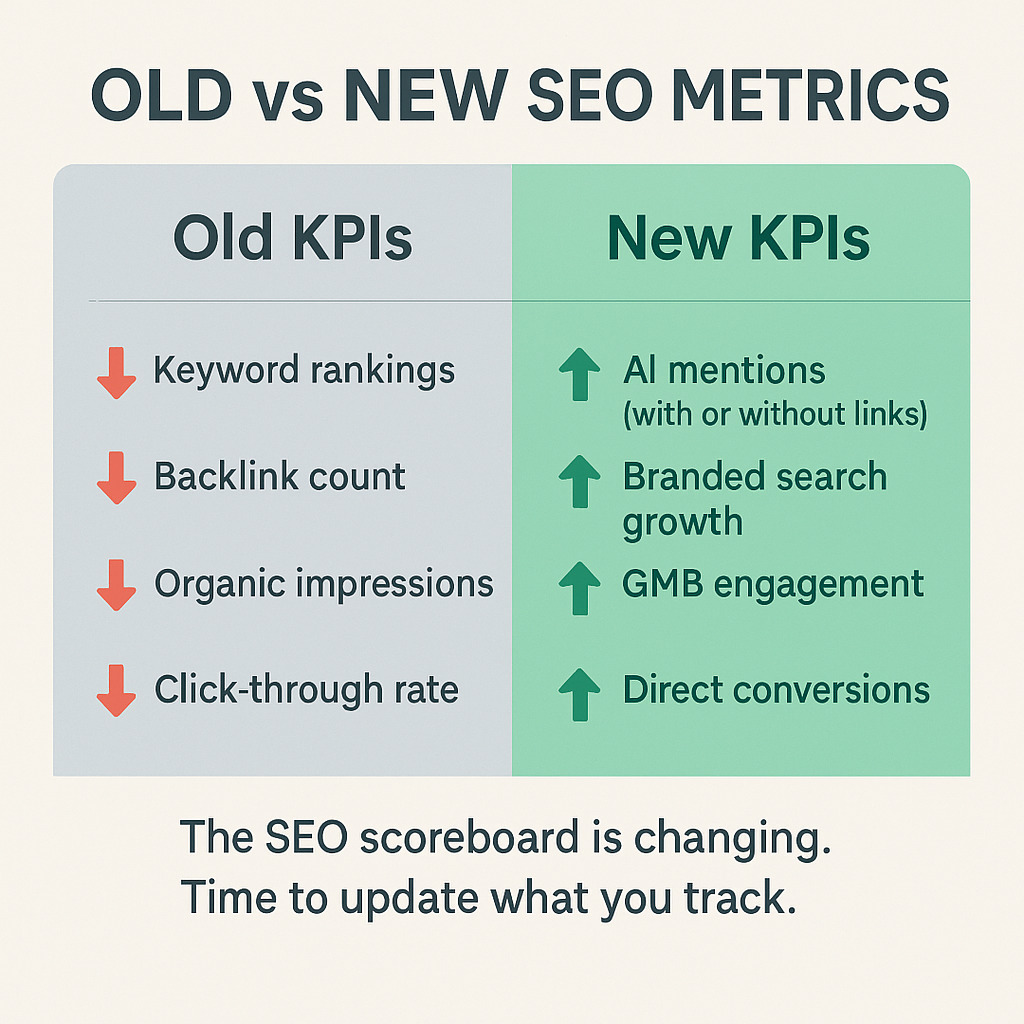
For years, SEO agencies in India have been judged by a familiar set of metrics—keyword rankings, clicks, impressions, and backlink counts. These numbers were the go-to proof of performance in almost every client report.
But that era is ending.
AI Mode doesn’t care about your position for “best laptop under 50000” or how many backlinks you’ve built from DA 60 blogs. Users aren’t scrolling through 10 blue links anymore. They’re getting direct answers inside Google, often without even seeing your link.
And this shift is just getting started.
What this means is that your traditional KPIs are becoming less relevant. Clients may still ask for rankings, but those rankings may not lead to traffic. Backlinks might help with authority, but they won’t help if the AI skips over your site completely. Impressions? Sure, they’ll rise—but they don’t mean visibility if your brand isn’t mentioned in the AI-generated summary.
What to Focus On Now:
- Brand Mentions in AI Summaries: Whether linked or not, being referenced in AI answers builds trust and awareness.
- Branded Search Growth: More people searching your brand name means you’re being remembered and recognized.
- Direct Traffic and GMB Interactions: These often come from AI visibility, even if the user doesn’t click through the traditional SERP.
- Conversions, Leads, and Bookings: The only numbers that actually matter to your client’s business.
- Client-Specific Engagement Metrics: GMB calls, form fills, tool usage, and video watch time are now more useful than pageviews.
If you’re still building reports around “we ranked 14 keywords in the top 10,” you’re already behind.
In the AI-first search world, the new question is:
Is your brand showing up where decisions are made, even when there’s no link?
2. Ranking Alone Won’t Be Enough
Ranking on page one used to be the goal. If your site was in the top 3 results, you could expect solid traffic. But that logic is breaking under AI Mode.
Now, even if your site ranks well in traditional search, users might never see it because AI Mode often skips the link-based results entirely. Instead, it shows a full answer generated from multiple sources, with or without attribution.
In many cases, your content might even be used to create the answer, but your brand isn’t shown or linked.
So you could be:
- Ranking high
- Providing great information
- Still getting zero traffic
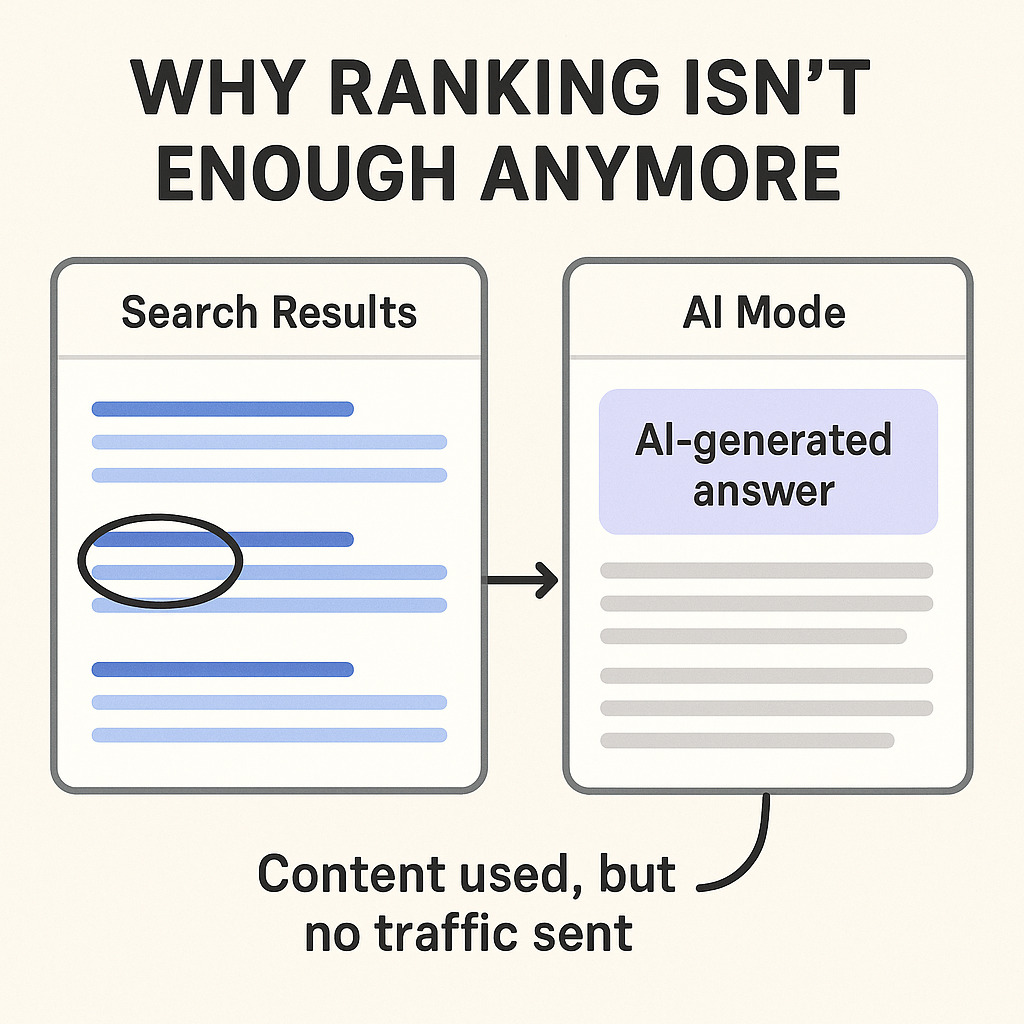
That’s frustrating. But it’s also a sign that SEO must evolve.
What to focus on instead:
- Build content that is clearly answer-focused, not just keyword-optimized
- Use schema markup to help AI identify sections like FAQs, reviews, comparisons, and how-tos
- Create content with strong topical authority so Google sees you as a go-to source in your niche
- Answer questions concisely within your pages using headings that match natural search queries
Visibility in AI Mode isn’t just about being ranked—it’s about being referenced, trusted, and selected by the system.
3. Branded Search Will Be More Valuable Than Ever
As AI-generated answers become the norm, generic queries like “best digital marketing agency” are showing fewer direct links and more AI summaries. In this environment, brand recall is everything.
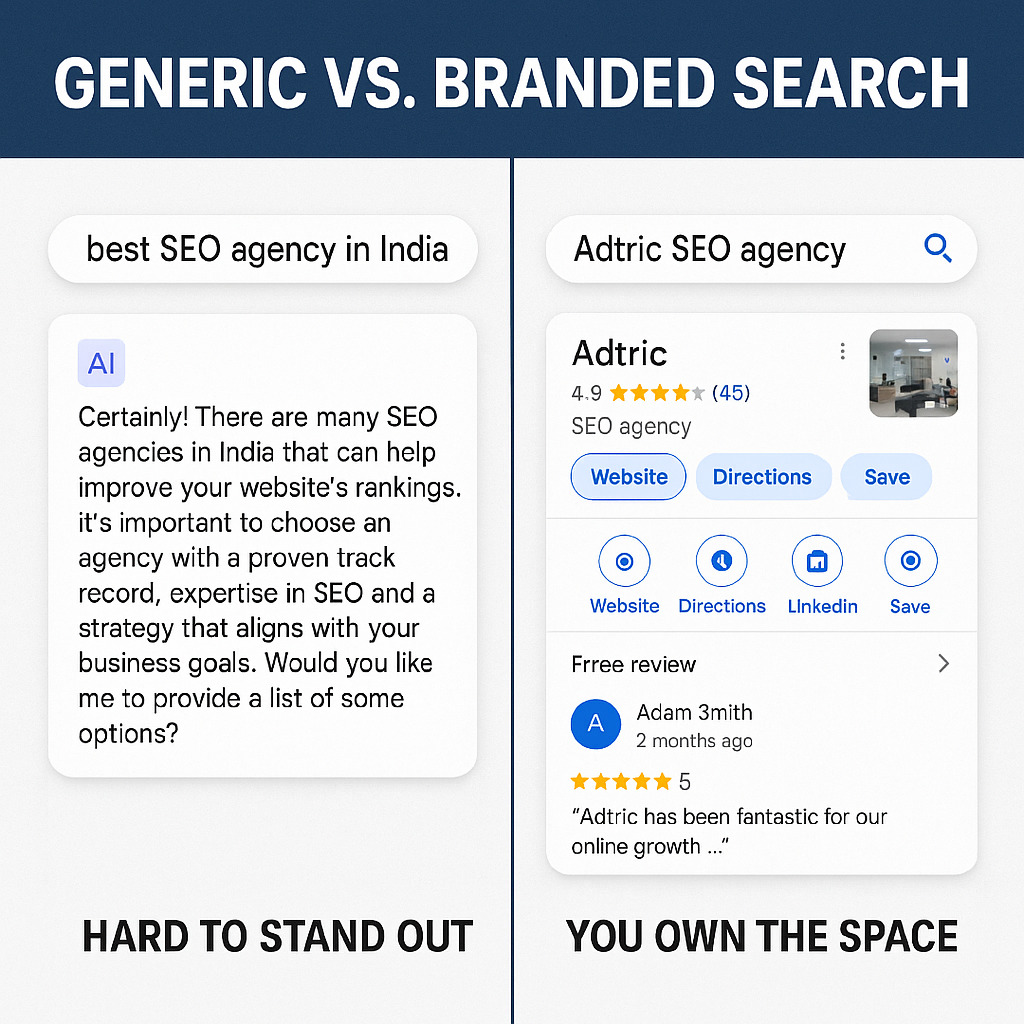
When someone searches for your brand directly—like “Adtric SEO Noida”—you bypass the competition, even in an AI-driven world. That’s because branded searches often lead to:
- Google My Business results
- Featured reviews
- Direct website links
- Stronger AI Mode mentions if your brand is already trusted
This is especially important in India, where people tend to compare brands before making decisions. Searches like:
- “Adtric vs WebChutney”
- “Best SEO agency in Pune for real estate”
- “[Brand] reviews and pricing”
…still trigger clicks and hold high commercial intent.
What to do now:
- Make sure your brand is mentioned in every piece of content you publish
- Create branded comparison pages (e.g., “Adtric vs XYZ: Who’s better for D2C SEO?”)
- Encourage users to search your name—through campaigns, ads, and social
- Track growth in branded queries using Google Search Console
The more users search for your brand by name, the better your visibility—across AI Mode, Maps, and even voice search.
4. Google Properties Come First
With AI Mode, Google isn’t just pulling data from websites. It’s prioritizing its own platforms—Google My Business (GMB), Merchant Center, Maps, Reviews, and Product Listings.
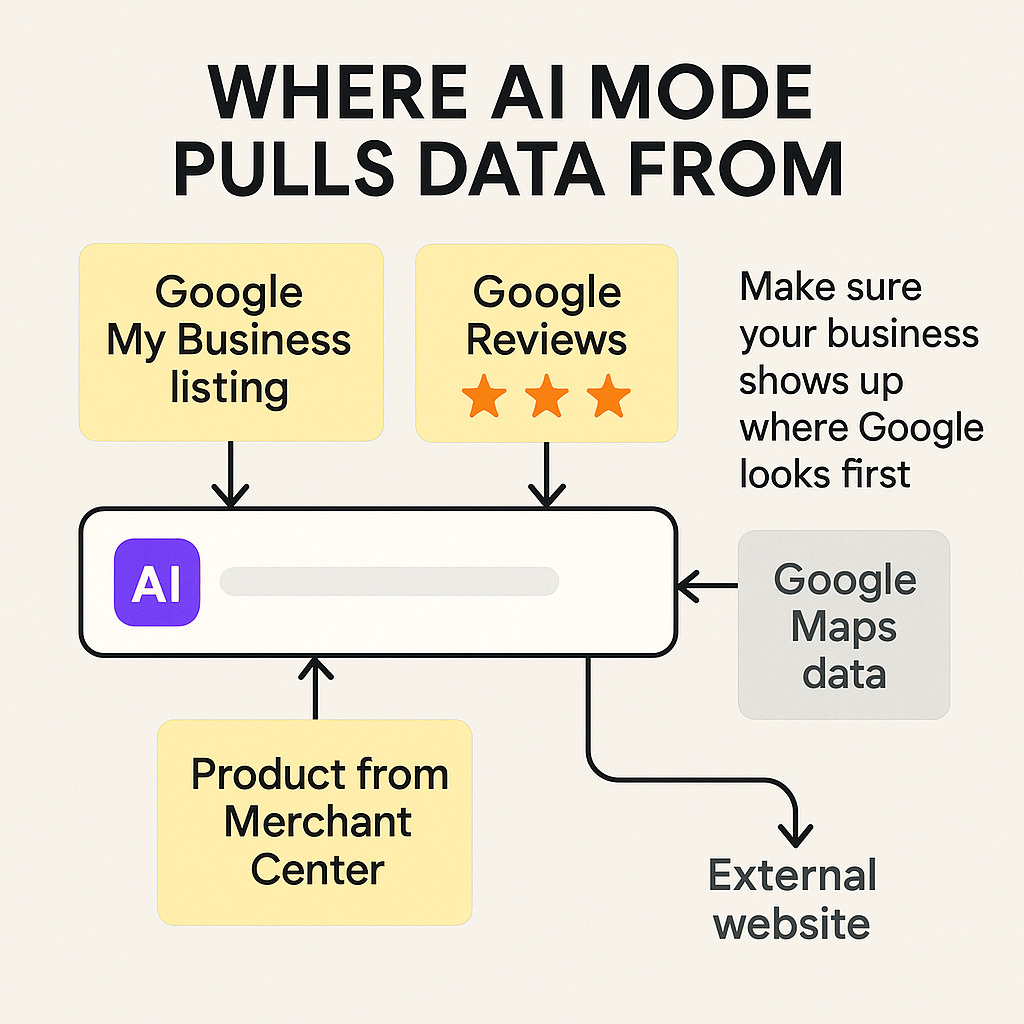
When someone searches for a local service, a product, or even a brand, Google often pulls info directly from these sources to power its AI response. These are structured, verified, and reliable in Google’s eyes—which is why they show up more often in AI answers.
For Indian SEOs managing clients across local, service-based, or eCommerce businesses, this shift is critical. Optimizing your own website is no longer enough. Your presence within Google’s ecosystem is now just as important—if not more.
What to do now:
- Fully optimize Google My Business listings:
- Add updated photos, services, working hours, posts, and Q&A
- Encourage regular reviews and reply to them
- Set up and maintain Google Merchant Center (for product-based businesses):
- Feed structured product data: title, price, availability, ratings
- Make sure your business is well-integrated into Google Maps
- Use local schema markup to support this presence across your own site
In many cases, AI Mode will skip your website entirely and show this Google-verified data front and center. That’s not a bug, it’s the new design.
5. Content Must Be Built to Answer, Not Just Rank
The old content game was about targeting the right keywords and writing long posts stuffed with SEO best practices. That doesn’t cut it anymore.
With AI Mode, Google isn’t just looking for content that matches a keyword—it’s looking for content that directly answers the user’s question. And it’s doing this at scale, across thousands of pages at once, pulling only what’s clear, structured, and useful.
AI Mode isn’t browsing your entire blog post. It’s scanning for short, clean answers. If your content is too vague, fluffy, or buried in long paragraphs, it gets skipped—even if you rank.
What to do now:
- Structure content around specific questions using natural language (e.g., What is the best tax software for freelancers in India?)
- Use clear headings, subheadings, and bulleted lists so Google can quickly identify and extract answers
- Focus on FAQ-driven pages, how-to guides, and product comparisons
- Give direct, concise answers first, then expand if needed (answer-first writing)
- Add schema markup for FAQs, how-to steps, products, and reviews
If your content can be quoted easily by an AI bot, it stands a better chance of being featured in summaries. The goal is not just to rank—it’s to be selected.
6. Sites Must Be AI-Ready, Not Just User-Friendly
Most SEOs focus on making sites easy for people to use. That’s still important. But in the AI search era, your site also needs to work well for machines specifically AI bots and autonomous agents.
AI Mode doesn’t browse like a human. It scans the structure, looks for clarity, and skips anything it can’t understand quickly. If your site is bloated, slow, cluttered, or uses complex JavaScript, AI might ignore it completely.
This is especially important in India, where many small businesses still run on basic CMS setups or outdated templates. These sites might look fine to people, but if AI bots can’t navigate them, they’re invisible to Google’s new systems.
What to do now:
- Make sure your HTML structure is clean: H1 → H2 → H3, proper tags, no broken layouts
- Avoid interstitials, pop-ups, or JS-heavy designs that block content from bots
- Ensure your forms (like lead gen or contact) are easily recognizable and simple for agents to interact with
- Focus on site speed, especially for mobile and low-bandwidth regions
- Use semantic HTML and logical content flow, so bots understand what each section means
7. Local SEO Will Get a New Boost
With AI Mode expanding globally, local and geo-targeted queries are going to play a bigger role—especially in India, where people rely heavily on mobile search, voice assistants, and region-specific content.
Whether it’s someone searching “best dentist in Thane” or “top MBA colleges in Indore”, AI Mode is now capable of understanding these local needs and surfacing relevant answers even before the user finishes typing.
Google is also pushing regional personalization. That means AI Mode will pull content from:
- GMB listings with updated info and reviews
- Location-specific pages on your site
- Local content in native or mixed language formats
- Structured data that clearly signals city, region, and services
This opens a huge window for Indian SEOs who can tap into regional keywords and build location-targeted authority.
What to do now:
- Create geo-specific landing pages for all your service areas or store locations
- Add FAQs and content in regional languages, where appropriate
- Use localBusiness schema and mark up address, hours, services, and more
- Encourage location-tagged reviews from real customers
- Add “near me” variations and natural language queries to your content
- Track performance regionally using GSC filters and local map insights
Local intent is often high-converting. AI Mode just makes it more visible if you’re optimized for it.
8. Tools and Interactivity Will Set You Apart
AI Mode can summarize blogs. It can pull quick answers from FAQs. But there’s one thing it still can’t do well interact with users in a way that involves inputs, choices, or tools.
That’s your advantage.
Interactive elements like calculators, quizzes, estimators, and checklists can’t be easily replaced by AI summaries. These features drive real user engagement and, most importantly, clicks. If a tool helps users do something like calculate loan EMIs, compare two products, or find the best fit based on inputs it creates utility that AI Mode can’t fully deliver.
For Indian SEO professionals working with real estate, education, finance, healthcare, or D2C brands, this is a huge opportunity. These tools don’t just rank they give people a reason to visit your site and take action.
What to do now:
- Build simple tools based on your niche:
- EMI calculators (real estate, loans)
- “Best product for me” quizzes (D2C, skincare, tech)
- Cost estimators (dentists, clinics, lawyers)
- ROI calculators (agencies, SaaS)
- Embed these tools on high-intent pages
- Mark them up with structured data when applicable
- Add strong CTAs to convert engaged users
- Track tool usage and conversions as part of your success metrics
These tools act like conversion magnets. They give users a reason to click—and stay.
9. Video and Social Content Will Influence AI
Google’s AI Mode isn’t just learning from websites. It’s also training on open web platforms like YouTube, Reddit, Quora, LinkedIn, and even public posts on social media.
That means content you publish outside your website can still influence what the AI shows.
Many users engage with brands through video, quick tips, or community posts especially on mobile. AI Mode sees that activity, and increasingly, it’s using it to shape search responses.
So while your blog post might not make it into the AI summary, your YouTube Shorts, Reddit answers, or even LinkedIn carousels might. Especially if they carry your brand voice, answer real questions, and get engagement.
What to do now:
- Repurpose high-performing blog content into:
- YouTube Shorts (explainer clips, listicles, voiceover reels)
- Reddit or Quora answers (with real commentary and examples)
- LinkedIn posts or carousels (especially B2B)
- Mention your brand name naturally in these responses to increase brand visibility in AI systems
- Add links back to your site where possible, but focus more on visibility than driving traffic
- Use tools like ChatGPT, Canva, and InVideo to scale this content across platforms
- Think of this as “Search Everywhere Optimization”, not just Google
Being visible where AI learns is just as important as being visible on your site.
10. Your Role Is Shifting from SEO to Strategy
Clients still ask about rankings. They still want traffic. But what they really need now is visibility, conversions, and digital trust across AI, search, social, and everything in between.
SEO in 2025 is no longer just about optimizing for keywords or improving on-page scores. It’s about positioning a brand to show up in AI answers, own conversations, and win trust signals wherever those signals happen.
This means your role as an SEO is evolving. You’re no longer just a technical expert. You’re a strategy partner, someone who understands how to keep a brand visible across changing platforms and user behavior.
For Indian SEO agencies and freelancers, this is a chance to lead. Many clients are still stuck in the old SEO playbook. They need someone to guide them through this shift.
What to do now:
- Reframe your value: Offer AI visibility audits, not just keyword tracking
- Educate your clients: Run workshops or strategy calls about Google AI Mode and what it changes
- Partner with content creators, video editors, developers because SEO is now a team sport
- Focus on results that matter: conversions, leads, engagement, branded search growth
- Build integrated SEO+content+AI strategies, not just blogs and backlinks
- Start testing how your content appears in AI tools like ChatGPT, Gemini, and Perplexity
The future of SEO is not about page 1—it’s about presence. If your brand shows up in answers, tools, and social feeds, you’re still winning.
The AI-First SEO Framework
Click-through rates have been declining for years long before AI Overviews and Gemini showed up. Most of us saw it happening. Impressions kept going up, but traffic didn’t follow. Until now, we could justify it by pointing to query growth. In 2024, Google hit over 5 trillion searches, with a 22% growth year. That masked the drop in CTR.
But that growth is now flattening. And AI Mode is here. We’ve officially entered the zero-click, zero-credit era of search.
This isn’t just Google’s doing. Every platform: Facebook, LinkedIn, YouTube, Reddit, X has moved toward keeping users on-platform, not sending traffic out. AI tools are no different. They scrape the web, generate answers, and send almost no clicks back.
So what now?
We stop chasing traffic. We start chasing influence.
The job of SEO has to evolve. We’re not just here to earn clicks—we’re here to get noticed, get remembered, and get chosen. Whether users transact on your site, or get their answers from AI using your data, your job is to be part of the moment they make a decision.
Here’s the new framework.
1. Visibility Is the New Ranking
Ranking #1 doesn’t guarantee attention anymore. Showing up in AI summaries and platform-native answers does.
- Test branded and service-related queries inside Google AI Mode and Gemini
- Monitor whether your content gets surfaced—even without a link
- Optimize for AI inclusion, not just blue link rankings
2. Make your site AI + Human Friendly
If AI bots can’t read your content clearly, it won’t be used in AI answers—no matter how helpful it is.
- Add schema for everything: FAQ, HowTo, LocalBusiness, Product, Reviews
- Use structured HTML (H1 → H2 → bullet points → CTA)
- Cut the fluff. Give straight answers early, then explain
- Test crawlability using tools like Mannis.im, Genspark, and Rich Results Test
3. Influence, Not Just Traffic
Traffic is becoming a vanity metric. Homepage visits are up, but middle-funnel traffic is disappearing. Focus on influencing brand perception and awareness, not just pageviews.
- Measure branded search growth, direct traffic, and GMB actions
- Focus on conversions, leads, calls, and downloads—not just pageviews
- Use brand-friendly phrases across platforms so AI connects content to your brand
- Use surveys and sentiment tracking to measure brand lift over time
4. Own the Platforms Google Pulls From
AI Mode sources from more than just websites. It learns from YouTube, Reddit, Quora, LinkedIn, Maps, and Merchant Center.
- Repurpose content into Shorts, carousels, and answer posts
- Keep your GMB and Merchant Center fully optimized
- Post weekly updates, FAQs, and service changes to GMB
- Add your brand to public discussions on Reddit and Quora
5. Create Answer Assets, Not Just Articles
AI can summarize long blogs, but it can’t recreate interactive tools or decision-focused content.
- Build tools as suitable and relevant for your business: EMI calculators, pricing estimators, “best for me” quizzes
- Create product comparison charts, industry checklists, and ROI breakdowns
- Make these tools central to your content strategy, not side projects
6. Run Monthly AI Visibility Audits
Most clients don’t know how AI search works. Help them understand it with visibility-first reports.
- Track:
- AI Mode inclusion (manual checks)
- Branded search trends (in GSC)
- GMB actions and map view growth
- Tool usage, form fills, and video views
- Build this into your monthly reporting
- Re-educate clients on what today’s visibility looks like
7. Design for Zero-Click Success
Don’t fight the trend. Lean into it. Create content that succeeds even if users don’t click.
- Add value inside summaries: use bold insights, comparisons, original stats
- Make sure your brand is referenced, even if it’s not linked
- Focus on brand recall—get users to come back by name
8. Test, Learn, Adapt (Without Attribution Obsession)
Attribution is broken. Most tools can’t tell you which platform influenced a decision. Stop over-optimizing for measurable clicks and start running real-world experiments.
Key shifts:
- Run brand lift experiments, not just traffic tests
- Track lift in GMB actions, branded search, DMs, and referrals
- Focus on memory, not just metrics
9. Think Like a Brand Strategist, Not Just an SEO
In this new era, SEO needs to work like brand positioning. You win by showing up in the answers people trust—even when there’s no link.
Key shifts:
- Define your narrative
- Make your brand a trusted name in the niche
- Control the conversation wherever it happens (even if it’s not on your site)
Final Thought
Adapt Early, Lead the Shift
We’re not dealing with a trend. We’re dealing with a transformation.
Google AI Mode is just the latest signal in a shift that’s been building for years towards zero-click search, content hoarding, and platform-first ecosystems. SEO is no longer just about traffic. It’s about visibility, trust, and influence across multiple surfaces, many of which won’t link back to your site at all.
If you’re feeling uneasy, that’s normal. I am too.
But that doesn’t mean SEO is dead. It means the work is evolving. We’re no longer here just to get people to click—we’re here to make sure our brand shows up where decisions happen, whether that’s in AI summaries, YouTube answers, or Google Maps results.
As Indian SEO professionals, we have an edge. We understand language diversity, local search behavior, and how to move fast. But we need to stop thinking in terms of old metrics and start building for a new environment.
This blog was written to give you a clearer picture and a real plan. Now it’s your move.
Final Takeaways
- Ranking is not enough. You need to be visible inside answers.
- Traffic is dropping. Start measuring influence, engagement, and brand lift.
- Don’t wait for clients to ask—educate and lead them.
- Build for humans, bots, and agents. Your website is just one touchpoint now.
- SEO isn’t going away. But the way we do it, measure it, and sell it has already changed.
Need Help Making the Shift?
If you’re an SEO agency, consultant, or in-house marketer in India and want to audit your AI readiness, rework your strategy, or just need help navigating what’s next—let’s connect.
